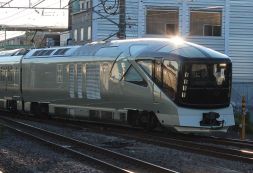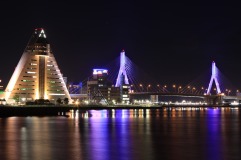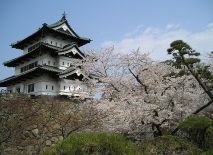Greetings all! This is the first of what could be a series of posts that will highlight the newest trend in Japanese train travel, and how you can experience the same journeys at a lower cost.
The various regional companies of the Japan Railways, or JR, have begun branching out over the years to offer new, high-end, luxurious, train trips. These new trains have taken on the nickname of “Cruising Trains”. Like a cruise on the open seas, these new train cruises aim to offer some of the finest experiences in train travel, allowing travelers to see wonderful parts of the country at a relaxed pace. They are successors to most overnight train services – the so-called “Blue Trains” – that used to run all across Japan for decades before their popularity declined thanks to the advent of bullet trains, regional airports and low cost air carriers.

One such trains that has been making headlines over the last few weeks is the cruise train called the Shiki-shima, operated by JR East.
The design of the train and amenities are impeccable. There are observation cars with lounges, suite rooms, and a first class dining car showcasing the best of Eastern Japan. As part of the planned itineraries, there is a mix of dining and sleeping on the train, with dining and sleeping in high-end accommodations at certain points of interest. The launching pad for the train trips is at Ueno Station in Tokyo, the traditional starting point for Japan’s train journeys to the north – though these days bullet trains, and more recently the opening of the Ueno-Tokyo through line, make Tokyo Station slightly more ideal.
There are two downsides to attempting a trip on the Shiki-Shima. First, the cost: expect to pay anywhere from $3,000 to $10,000 for a journey that takes no longer than 4 days. For the most recent offered itinerary – 3 days and 2 nights this winter – fares started at $6,500 single occupancy and $4,400 per person double occupancy for a… “standard” suite in US dollars at present exchange rates.
The second downside is whether or not you are able to secure a trip in the first place. Despite the exorbitant cost, travelers want to take trains like these. JR East is overwhelmed with trip applications that they conduct a lottery to see who will receive the privilege of taking a trip. Occasionally, travel agencies will secure a small number of trips on trains like these and sell them, tacking a large commission on top of the original price.
Don’t let this get you down though… you can still plan your own trip using Japan’s renowned transit systems, which include bullet trains and nice-looking limited express and tourist trains, with a more respectable budget.
To demonstrate, I’ve taken apart one of the itineraries that will be offered on the Shiki-Shima and will show you how to make a similar journey using regularly scheduled train services.
Original Shiki-shima Itinerary
What follows is the original itinerary for the most recent journey to sell out: the 3-day, 2-night Winter cruise on the Shiki-shima train, per the information on the JR East website.
Day 1: Ueno – (lunch on the train) – Shiroishi (sightseeing) – (Dinner outside the train) – Board the Shiki-shima at Matsushima and spend the night on the train.
Day 2: (Breakfast on the train) – Aomori – Hirosaki (sightseeing) – (lunch outside the train) – return to the train at Aomori (dinner inside the train) – Ichinoseki (sightseeing) – spend the night on the train.
Day 3: Naruko-Onsen station – (breakfast on the train) – Sightseeing in Naruko-Onsen – (lunch on the train) – Arrive at Ueno Station.
With this itinerary in mind, let’s see what a trip would look like by taking the regular services… that is, anything regularly scheduled, including bullet trains. While the cruising train starts and ends at Ueno Station, I’ll include a few other options for consideration.
Jose’s Itinerary
Day 1:
*Shinkansen Yamabiko/Tsubasa #131, Depart Tokyo 9:24, Omiya 9:48, Arrive Fukushima 10:46
Every day, this Yamabiko service makes a fast run from Tokyo to Fukushima in only 82 minutes, stopping only at Omiya. The Yamabiko continues to Sendai, and the Tsubasa continues to Yamagata and Shinjo.
If leaving from Ueno, you can board the Nasuno #255 departing Ueno 9:22 and arriving Omiya at 9:41 to connect to the above service.

Spend an hour in the Fukushima station surroundings… perhaps have a quick meal while you are there. Then, travel to Shiroishi by regular JR train:
*JR Tohoku Line Local, Depart Fukushima 11:47, Arrive Shiroishi 12:22
Spend the afternoon in Shiroishi. Enjoy the restored Shiroishi Castle, or sample one of the staples of Shiroishi’s cuisine… Umen noodles, which are cooked without oil.
In the late afternoon, depart for Aomori.

*JR Tohoku Line Local, Depart Shiroishi 16:19, Arrive Sendai 17:09
(Alternate: Go a bit further east to Shiroishi-Zao station, take Shinkansen Yamabiko #143, Depart Shiroishi-Zao 16:50, Arrive Sendai 17:04)
*Shinkansen Hayabusa #27, Depart Sendai 17:54, Arrive Shin-Aomori 19:37
*Take a shuttle train to Aomori, arriving 19:57
Check into a hotel in Aomori and spend the evening. For dinner you could have something quick in Sendai, or perhaps buy a bento box in Sendai Station to have on the Hayabusa service. You could also have a late dinner in Aomori.

Day 2:
After breakfast in Aomori, take a limited express train to Hirosaki:
*Tsugaru #2, Depart Aomori 9:05, Arrive Hirosaki 9:36
Spend the day in Hirosaki, visiting the Hirosaki Castle with its preserved samurai buildings nearby. After sightseeing and lunch, depart for Ichinoseki.
*Tsugaru #3, Depart Hirosaki 14:52, Arrive Shin-Aomori 15:22
*Hayabusa #26, Depart Shin-Aomori 15:52, Arrive Morioka 16:44
*Hayabusa #108, Depart Morioka 17:07, Arrive Ichinoseki 17:47
Check into a hotel in Ichinoseki, have dinner and spend the evening.

Day 3:
After breakfast in Ichinoseki, depart for the scenic Naruko Gorge. The gorge offers spectacular views, and is especially popular in the fall and winter months.
*Hayabusa #104, Depart Ichinoseki 8:48, Arrive Furukawa 9:05
*JR Rikku East Line Local, Depart Furukawa 9:19, Arrive Naruko-Onsen 10:02
After sightseeing and lunch in Naruko, return to Tokyo to complete your trip.
*JR Rikku East Line Local, Depart Naruko-Onsen 14:10, Arrive Furukawa 14:57
*Shinkansen Yamabiko #50, Depart Furukawa 15:09, Arrive Omiya 16:58, Ueno 17:18, Tokyo 17:24
Trip Costs

For the three-day itinerary above, an excellent option if you do not have the national Japan Rail Pass is the JR East Tohoku Area Pass for 19,000 yen. With this pass you can travel anywhere in JR East territory from Tokyo to Tohoku (northern Honshu). You get five flexible days of travel over a 14 day period and can make free seat reservations in standard class on all the bullet trains mentioned above. Note that when you use the Hayabusa bullet train seat reservations are compulsory.
With the two other days remaining, why not explore other areas included in the pass? Perhaps check out Matsuyama (part of the Shiki-Shima tour but excluded from my itinerary), or make a quick bullet train run to Echigo-Yuzawa to cheaply sample many regional types of sake and possibly bring a bottle home with you!

If you want to float in the middle of the road as far as accommodations are concerned, you can certainly look into cheap business hotels. For a random weekday in June 2017, business hotels in Aomori were spotted two blocks east of Aomori Station for as low as 2,300 yen per person double occupancy. Near Ichinoseki Station they were spotted at 4,700 yen per person double occupancy.
For meals, my conservative estimate would be around 4,000 yen per person a day, counting all meals. Bento box meals and convenience store meals will certainly reduce this cost.
When the cost of the JR East Tohoku Pass, maximum conservative food budget and accommodation charges are added over a period of 3 days, the estimated cost per person comes out to around 38,000 yen ($335)… well under the 500,000 yen charged per person double occupancy on the Shiki-shima. Costs to visit attractions, and costs for souvenirs, are not included.
It helps to make seat reservations on the shinkansen and limited express trains; as mentioned above, Hayabusa reservations are compulsory. Make your seat reservations for the Hayabusa, Yamabiko, Tsubasa and Tsugaru at a JR train station in Tokyo, preferably at one of the JR East Travel Service Centers (Tokyo, Shinjuku or Ikebukuro Stations), before you start your trip.
It’s my hope that as you consider this, you will make your own travel plan for Japan… whether it be around these areas or other parts of this wonderful country… at a budget that suits you. Please feel free to share your thoughts, or perhaps any other itineraries that you may come up with.
All information is offered pursuant to the blog disclaimer.
Links to Creative Commons licenses: CC BY 3.0, CC BY-SA 3.0
